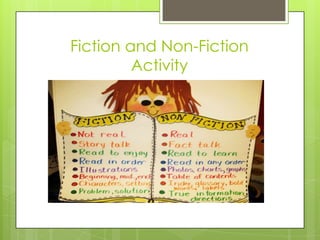
Chapter 3, 4 and 5
- 1. Fiction and Non-Fiction Activity
- 2. Chapter 3:Welcoming ELLs into the Classroom
- 3. The Role of ELL Guides Choose four to six boys and girls to be guides and explain their role before ELLs arrive. Guides are to be the newcomers’ first companions. Guides job is to demonstrate to the newcomer how class work is to be done.
- 4. The Teacher’s Role Teacher would balance her time in a mixed-language and mixed-ability classroom. Teacher have to make sure that students are engaged in work while she is meeting with ELL’s small groups or individuals.
- 5. Greeting a Newcomer Teacher and class should greeted warmly to ELL. The newcomer should be seat next to his students guided. Lunch meeting are the best way to know the ELL and present him the welcome kit. Let the ELL know that the student guide will be his helper.
- 6. Welcome the ELL as a Unique Person Welcoming time should be friendly and undemanding and the orientation gradual. Teacher and the guide should try to learn to say and write a few phrases from the newcomer’s language such as greetings.
- 7. Chapter 4: Beginning English Instruction There are three levels of ELL and their implications for teaching in Figure 4.1. Effects of Personal Characteristics on Learning: there are two types of new comers, the outgoing and the quieter. Initial English Instruction Teaching Vocabulary and Sentence Structure.
- 8. Chapter 5:Teaching Reading and Writing Five Supports to Become Successful Readers in English. 1. Materials that are appropriate. 2. The introduction of background information and vocabulary before reading a book or a story. 3. An overview of the specific material to be read. 4. Comprehension assistance during reading. 5. Opportunities to review material after the initial reading.
- 9. Teaching Reading and Writing The benefits of reading aloud Increases children’s vocabularies Supports comprehension SupportingELLs’ Writing Provide good models
- 10. Class Discussion Did you find Yatvin’s suggestion of modeling good writers to be an insult and/or disrespectful to an ELLs’ individuality and their culture?